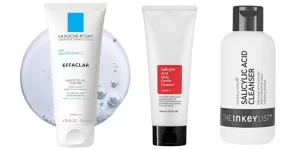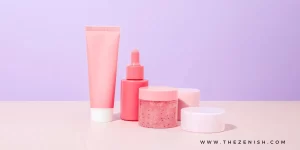
Topical retinoids are a popular way of treating acne. Tretinoin and adapalene (both derivatives of vitamin A) are two of the most popular retinoid treatments available. So which is better adapalene vs tretinoin for hyperpigmentation?
One is a prescription-only medication and the other is a newer, retinoid available both as a prescription medication and as an over-the-counter acne treatment.

Tretinoin and adapalene are both parts of the same class of medications and generally offer similar benefits, so picking one over the other can be tricky.
On paper, they both look pretty much the same with similar benefits and potential risks.
Both tretinoin and adapalene help speed up cellular turnover and help dead skin cells to shed faster, speeding collagen production and revealing a smoother, brighter, clearer, and more uniform complexion with continuous use.
We’ve compared the two to see which is best.
| this post may contain affiliate links, which means if you purchase from one of these links, I may receive a small commission at no additional cost to you. |
Adapalene
Pros
- affordable
- available over the counter
- suitable for sensitive skin
- won’t cause excessive peeling
- better for acne
- okay to use during the morning
- okay for rosacea
- okay to use during pregnancy
Cons
- unlikely to improve deep lines & wrinkles
FDA approved in 1996, adapalene is a third-generation retinoid used for both acne prevention and treatment of acne by prescription and as an over-the-counter gel.
It has several characteristics that make it quite unique when compared to tretinoin.
First, adapalene can stop your skin from producing more blackheads by fighting the differentiation of cells in a tissue called the keratinocytes.
It can also improve inflammation and help exfoliate old blackheads by interfering with the process of oxidizing their cells.
A major upside of adapalene is that it has a more stable structure when compared to tretinoin and is safe to use with other acne medications, such as benzoyl peroxide.
Studies have shown that adapalene is very effective at treating acne. One study showed that 69-74% of patients saw dramatic reductions in inflammatory and non-inflammatory acne lesions.
And according to some studies, adapalene appears to be less likely to cause irritation than tretinoin.
Adapalene is available in several different strengths and is usually sold with other over-the-counter products under the brand name Differin.
It comes in four different forms: lotion (0.1%), cream (0.1%), solution (0.1%), and gel (0.3%). Currently, the stronger .03% gel is only available with a prescription.
Unlike tretinoin, which is exclusively a prescription drug, the lower-strength, 0.1% forms of topical adapalene are available over-the-counter in most pharmacies.
Tretinoin
Pros
- improves acne & post-inflammatory hyperpigmentation
- improves uneven skin texture
- improves signs of aging (deep lines and wrinkles)
Cons
- can be irritating
- not a great option for very sensitive skin
- unsuitable for rosacea
- no okay to use during pregnancy
First used as a treatment for various skin disorders, tretinoin was discovered as a potential acne treatment in 1969 and was approved by the FDA in 1971 as the first retinoid to help treat acne vulgaris.
In the US, tretinoin is sold as a prescription medication and needs to be prescribed by your doctor before you can buy it from a pharmacy.
Tretinoin is usually in a cream or gel when used to treat acne and anti-aging issues.
Tretinoin can take several months before you notice any real results, so it’s important to be patient and understand that it’s a process that will take time.
Topical tretinoin comes in several different strengths, ranging from .01% to .1%.
Most tretinoin users start by using a cream or gel with a low to moderate concentration and adjust the dosage based on their results and side effects.
In general, tretinoin is a well-studied drug shown to significantly benefit patients with acne and aging skin.
Adapalene vs Tretinoin: What’s the difference?

The primary difference between tretinoin and adapalene is that tretinoin has been proven to improve the visible signs of skin aging such as fine wrinkles or deep wrinkles, dark spots, hyperpigmentation and reducing acne.
Tretinoin is a better anti-aging option than adapalene, which has mainly been studied for treating acne.
Adapalene is less irritating than tretinoin and, while clinical studies have shown that it is as efficient as 0.25% tretinoin, this active ingredient is generally better tolerated by all skin types.
On the other hand, tretinoin can be really irritating for sensitive skin, so users may need time to get used to the active ingredients and may experience more side effects while getting used to the effects.
Lastly, adapalene has a unique, stable profile that allows it to be used in the morning. Tretinoin on the other hand is unstable in UV light, which is why it’s strictly recommended to be used in the evening.
Adapalene vs Tretinoin: Which medication is more effective?
Both prescription retinoids, tretinoin and adapalene, are effective in treating acne, but a review of research found that tretinoin gel at .05% strength is more effective than adapalene at 0.1%.
Nevertheless, assuming people are compliant with their treatment plans, both can be equally effective.
This means that some people with persistent, severe acne may find that the tretinoin cream works much better than the .1% over-the-counter form of adapalene.
But it’s best to discuss your options with a healthcare provider before settling on anything.
Studies show that tretinoin typically produces slightly higher levels of skin irritation than adapalene and research suggests that tretinoin has a higher skin irritation potential when used as a long-term acne prevention treatment.
So If you have irritated sensitive skin that often breaks out in rashes, and is itchy or uncomfortable, then you may find adapalene less irritating and more suited to your skin’s needs.
Which cream should you choose?
Choosing between adapalene and tretinoin is easy because whichever option you choose will give you results. If you have acne, sensitive skin, or easily irritated skin, then choose adapalene.
However, if your skin is resilient and you’d like to target other common skin concerns, such as the appearance of fine lines, signs of aging, age spots and hyperpigmentation, then choose tretinoin.
In general, tretinoin and adapalene both work well to improve, remove and prevent acne.
Both drugs can take a few months before you notice the effects – both have a temporary “purge” period where it’ll look like your skin is getting worse before it looks better.
Tretinoin is the best option if you want to fight the signs of aging, it has a good track record of reducing wrinkles, hyperpigmentation and other signs of skin aging.
You’ll also want to consider the laws in your country. Adapalene is readily available without a prescription in the US but may require a prescription in other countries.
Can you use Adapalene and Tretinoin together?
Adapalene and tretinoin give very similar results and it isn’t necessary to use both together. If you want an anti-aging boost and acne treatment, tretinoin is a great choice.
Using tretinoin and adapalene together is unnecessary and may have negative consequences for your skin. By using them together, you’re much more likely to cause dry skin or irritation.
Which could result in rosacea, a long-term skin condition that makes the skin sensitive.
What are the side effects?

Both adapalene and tretinoin have temporary and common side effects, such as irritation, purging, and peeling. It’s important to introduce them gradually into your skincare routine to reduce the intensity of any side effects, especially if you have a skin type susceptible to irritation.
Here are some of the common side effects of using adapalene and tretinoin:
Sun sensitivity
While adapalene or tretinoin is doing its job on your pores, it will likely make your skin more sensitive to sunlight.
This happens because the rapid shedding of cells will slow the skin down from protecting itself from the sun.
So keep in mind that now you’re using tretinoin or adapalene, you might get sunburned sooner and easier than before. And for this reason, you’ll want to include sun protection into your daily skin care routine.
This is why it’s crucial to wear sunscreen when using retinoids since sun damage on the skin is more severe when the skin is vulnerable.
If you experience sudden warmth on your face, unrelated to the temperature, it can be a sign that your retinoid cream is working and that you need to apply sunscreen to protect your skin.
Purging
Both adapalene and tretinoin work by speeding up cellular turnover, which can cause dead skin cells that didn’t shed properly to mix with skin oil and clog the surface of the skin.
So when you start using retinoids, your skin will purge the clogs to the surface and turn them into pimples so that they can heal and disappear.
Unfortunately, because all these pimples will most likely surface at the same time, instead of over a period of days or weeks, most users are tempted to think the treatment isn’t working, when it is, and this purging is actually a good thing.
A purge can last anywhere from 8-12 weeks and it’s not uncommon for it to last six months or even a year.
Certain skincare or makeup products can definitely add to the clogging of pores and make your purge period longer.
So to help shorten your purge period, use makeup and skin care products that won’t clog your pores.
Peeling
Other potential side effects of using tretinoin include redness, peeling, and flaking skin. This can be seen anywhere that tretinoin is applied, including around the mouth.
It’s also important to thoroughly wash your hands after using tretinoin as it will also cause your fingers and hands to peel.
One downside of using adapalene gel is that you may experience a bit of dryness on your fingers, but peeling doesn’t happen very often and there’s less irritation.
It’s best to wash your hands with soap after each use to lessen these side effects.
Dryness and irritation
Adapalene and tretinoin work by speeding up the skin cell turnover cycle, helping remove the old layer of skin faster than usual.
Your skin can become dry and flakey in response as it purges and peels. This is a temporary side effect, but your skin will adjust over time.



